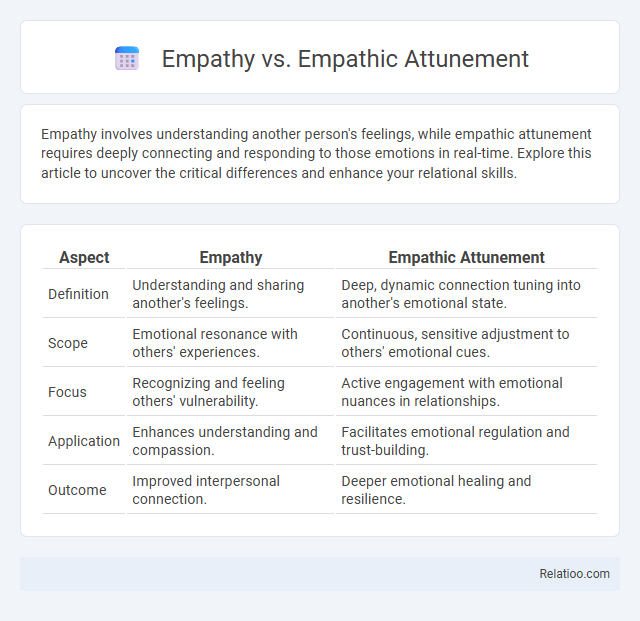Empathy involves understanding another person's feelings, while empathic attunement requires deeply connecting and responding to those emotions in real-time. Explore this article to uncover the critical differences and enhance your relational skills.
Table of Comparison
| Aspect | Empathy | Empathic Attunement |
|---|---|---|
| Definition | Understanding and sharing another's feelings. | Deep, dynamic connection tuning into another's emotional state. |
| Scope | Emotional resonance with others' experiences. | Continuous, sensitive adjustment to others' emotional cues. |
| Focus | Recognizing and feeling others' vulnerability. | Active engagement with emotional nuances in relationships. |
| Application | Enhances understanding and compassion. | Facilitates emotional regulation and trust-building. |
| Outcome | Improved interpersonal connection. | Deeper emotional healing and resilience. |
Understanding Empathy: Definition and Key Concepts
Empathy involves recognizing and sharing another person's emotions, forming the foundation for effective interpersonal connections. Empathic attunement deepens this understanding by tuning into subtle emotional cues and responding genuinely to your feelings and experiences. Developing empathic attunement enhances your ability to connect authentically, fostering trust and emotional support in relationships.
What Is Empathic Attunement?
Empathic attunement refers to the deep, intuitive understanding and connection you establish by recognizing and resonating with another person's emotional state. It goes beyond empathy by involving active engagement and responsiveness to subtle emotional cues, fostering genuine emotional bonding and psychological safety. Your ability to practice empathic attunement enhances communication, trust, and emotional insight in personal and professional relationships.
Empathy vs Empathic Attunement: Core Differences
Empathy involves recognizing and understanding another person's emotions, while empathic attunement goes deeper by actively tuning into and resonating with those emotions on a more immersive level. Empathic attunement engages both emotional and physiological responses, facilitating a shared emotional experience beyond cognitive understanding alone. The core difference lies in empathy as an intellectual awareness, whereas empathic attunement embodies a dynamic, embodied connection reflecting authentic emotional harmony.
The Neuroscience Behind Empathy and Attunement
Neuroscience reveals that empathy involves activation of mirror neuron systems and regions like the anterior insula and anterior cingulate cortex, enabling emotional sharing and understanding others' feelings. Empathic attunement extends this by engaging the brain's limbic system, fostering deep emotional resonance and synchronous interaction between individuals. These neural mechanisms underscore the dynamic process where empathic attunement facilitates mutual regulation and heightened social connection beyond basic empathetic response.
Emotional Resonance: The Heart of Attunement
Emotional resonance forms the core of empathic attunement, enabling deep connection through shared feelings and authentic understanding of another's emotional state. Empathy involves recognizing and sharing emotions, while empathic attunement intensifies this process by actively tuning into subtle emotional cues and nonverbal signals. This heart of attunement fosters meaningful interpersonal bonds, enhancing emotional communication and psychological responsiveness.
Real-Life Examples: Empathy in Action vs Attunement
Empathy involves recognizing and understanding another person's emotions, such as comforting a friend after a loss by sharing in their feelings. Empathic attunement deepens this connection by tuning into subtle cues like tone and body language, allowing you to respond with genuine care during conversations. Your ability to practice empathic attunement enhances real-life interactions by fostering trust and emotional resonance beyond basic empathy.
The Role of Empathic Attunement in Relationships
Empathic attunement plays a crucial role in relationships by enabling individuals to deeply understand and resonate with each other's emotional states, fostering genuine connection and trust. Unlike general empathy, which involves recognizing another's feelings, empathic attunement requires an active, ongoing sensitivity to subtle emotional cues, enhancing communication and emotional regulation. Research shows that couples with high levels of empathic attunement report greater satisfaction and resilience in managing conflicts, highlighting its importance in sustaining healthy interpersonal bonds.
Benefits of Practicing Empathic Attunement
Practicing empathic attunement enhances interpersonal relationships by fostering deeper emotional understanding and trust, leading to improved communication and conflict resolution. This skill increases emotional intelligence, allowing individuals to accurately perceive and respond to others' feelings, which promotes psychological well-being. Empathic attunement also supports effective leadership and teamwork by creating an environment of empathy and mutual support.
Barriers to Empathy and Attunement
Barriers to empathy include cognitive biases, emotional overload, and lack of perspective-taking, which hinder genuine understanding of another's feelings. Empathic attunement requires careful emotional resonance and sensitivity, and obstacles such as distractions, defensive attitudes, or past trauma can disrupt this deep connection. Overcoming these barriers involves conscious effort to remain present, open, and nonjudgmental to foster authentic interpersonal attunement.
Cultivating Deeper Connection: Steps Toward Empathic Attunement
Cultivating deeper connection through empathic attunement involves actively noticing and responding to your partner's emotional states with sensitivity and presence. Empathy is understanding what another feels, while empathic attunement goes further by synchronizing your emotional responses to create mutual understanding and trust. Your ability to engage in empathic attunement steps, such as focused listening and emotional validation, builds stronger relational bonds that foster genuine intimacy.

Infographic: Empathy vs Empathic Attunement
 relatioo.com
relatioo.com